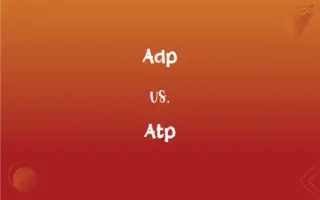Hypocotyl vs. Epicotyl: What's the Difference?
Edited by Aimie Carlson || By Harlon Moss || Updated on October 28, 2023
Hypocotyl is the stem region below the seed leaves (cotyledons) and above the root, while epicotyl is the stem portion above the cotyledons leading to the shoot tip.

Key Differences
The hypocotyl and epicotyl are vital segments of a young plant's stem. In germinating seedlings, the hypocotyl is the part of the stem situated between the root and the cotyledons, or seed leaves. The epicotyl, conversely, is the section of the stem above the cotyledons, connecting them to the first true leaves.
During seed germination, the hypocotyl plays a significant role by elongating and pushing the cotyledons above the soil surface. This aids in the plant's exposure to sunlight. On the other hand, the epicotyl's elongation ensures the plant’s shoot system develops properly, paving the way for the plant's first true leaves to expand and photosynthesize.
Both hypocotyl and epicotyl segments are crucial during the early stages of plant growth. While the hypocotyl is responsible for lifting the seed leaves towards light, the epicotyl ensures the upward growth of the shoot, guaranteeing the plant's exposure to sunlight for photosynthesis.
In many dicotyledonous plants, the hypocotyl is often observed as the first stem that appears during germination. This stem pushes upwards, lifting the cotyledons out of the ground. The epicotyl, however, starts its growth after the hypocotyl has done its job, ensuring the shoot tip and subsequent leaves grow upward.
Some plants exhibit unique behaviors with their hypocotyl and epicotyl. For example, in certain seeds, the hypocotyl remains short and the cotyledons don't rise above the soil. In contrast, the epicotyl's growth leads to the emergence of the true leaves above ground.
ADVERTISEMENT
Comparison Chart
Position
Between root and cotyledons
Above cotyledons leading to shoot tip
Function
Pushes cotyledons above soil
Growth of the shoot system
Appearance
First visible stem in many dicots
Follows hypocotyl's growth
Germination
Responsible for initial upward growth
Ensures upward growth of the true leaves
Role in Growth
Lifts seed leaves towards light
Aids in the expansion of true leaves
ADVERTISEMENT
Hypocotyl and Epicotyl Definitions
Hypocotyl
A plant's stem segment between the root and cotyledons.
In bean seedlings, the hypocotyl is clearly visible as it pushes the seed leaves above the ground.
Epicotyl
The segment that connects cotyledons to the first true leaves.
In some plants, the epicotyl grows rapidly, ensuring quick exposure to sunlight.
Hypocotyl
The initial stem visible during many dicot plants' germination.
As the seed germinated, the hypocotyl elongated, lifting the cotyledons upwards.
Epicotyl
The portion of a seedling's stem above the cotyledons leading to the shoot tip.
Following germination, the epicotyl's growth leads to the emergence of the plant's true leaves.
Hypocotyl
The stem segment ensuring initial upward growth in many seedlings.
By observing the hypocotyl's development, one can determine the seedling's health.
Epicotyl
A structure aiding in the expansion and positioning of true leaves.
The health of the epicotyl can often determine the successful development of a young plant.
Hypocotyl
A structure responsible for elevating cotyledons during germination.
The seed's hypocotyl aids in exposing it to sunlight for photosynthesis.
Epicotyl
A part responsible for the upward growth of the shoot system.
The elongation of the epicotyl is crucial for the plant's photosynthetic activity.
Hypocotyl
The part of a seedling stem below the seed leaves.
The length of the hypocotyl can vary among plant species.
Epicotyl
The stem section that grows post hypocotyl's elongation.
After the hypocotyl has lifted the seed leaves, the epicotyl takes over in growth.
Hypocotyl
The part of a plant embryo or seedling plant that is between the cotyledons and the radicle or root.
Epicotyl
The stem of a seedling or embryo located between the cotyledons and the first true leaves.
Hypocotyl
(botany) In plants with seeds, that portion of the embryo or seedling between the root and cotyledons.
Epicotyl
(botany) In plants with seeds, that portion of the embryo or seedling above the cotyledons.
FAQs
How does the epicotyl contribute to a plant's growth?
The epicotyl ensures the upward growth of the shoot system.
What's the position of the hypocotyl in a seedling?
The hypocotyl is located between the root and the cotyledons.
Does the epicotyl grow before the hypocotyl?
No, the epicotyl grows after the hypocotyl has lifted the cotyledons.
What's the primary function of the hypocotyl during germination?
The hypocotyl pushes the cotyledons above the soil.
In which type of plants is the hypocotyl prominently visible during germination?
The hypocotyl is prominently visible in many dicotyledonous plants.
Why is the epicotyl's position important for a young plant?
The epicotyl's position ensures proper development and exposure of the shoot system to light.
How does the epicotyl differ in monocots and dicots?
In dicots, the epicotyl is the segment above the cotyledons, while in many monocots, it may not be as distinctly present.
Does the epicotyl always grow at the same rate in all plants?
The growth rate of the epicotyl can vary based on species and environmental factors.
Are the functions of the hypocotyl and epicotyl interconnected?
Yes, the hypocotyl's growth precedes and facilitates the growth of the epicotyl in many plants.
What happens if the hypocotyl remains short?
If the hypocotyl remains short, the cotyledons might not rise above the soil surface.
Can environmental factors affect hypocotyl growth?
Yes, factors like light and temperature can influence hypocotyl growth.
Do both hypocotyl and epicotyl play roles in anchoring a plant?
While the hypocotyl aids in lifting seed leaves, it's primarily the roots, not the epicotyl, that anchor the plant.
Where is the epicotyl found in relation to the cotyledons?
The epicotyl is the stem portion found above the cotyledons.
Can a plant grow without a properly functioning hypocotyl?
A non-functional hypocotyl can hinder the plant's ability to lift its seed leaves towards light.
Is the epicotyl essential for photosynthesis?
While the epicotyl itself doesn't photosynthesize, its growth ensures that true leaves are positioned for optimal photosynthesis.
Is the hypocotyl present in all types of plants?
The hypocotyl is predominantly a feature of dicotyledonous plants.
What determines the length of the epicotyl in a seedling?
Genetic factors and environmental conditions can influence the length of the epicotyl.
How does the growth of the epicotyl impact a plant's first true leaves?
The epicotyl's growth positions the true leaves for better exposure to sunlight.
Can the length of the hypocotyl vary among different plant species?
Yes, the length of the hypocotyl can differ significantly among species.
Is the hypocotyl vital for photosynthesis?
The hypocotyl itself doesn't photosynthesize, but its function ensures cotyledons get light exposure, which is crucial for photosynthesis.
About Author
Written by
Harlon MossHarlon is a seasoned quality moderator and accomplished content writer for Difference Wiki. An alumnus of the prestigious University of California, he earned his degree in Computer Science. Leveraging his academic background, Harlon brings a meticulous and informed perspective to his work, ensuring content accuracy and excellence.
Edited by
Aimie CarlsonAimie Carlson, holding a master's degree in English literature, is a fervent English language enthusiast. She lends her writing talents to Difference Wiki, a prominent website that specializes in comparisons, offering readers insightful analyses that both captivate and inform.































































